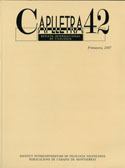La dislocació a la dreta en català i castellà: microvariació en la interfície sintaxi/pragmàtica
DOI:
https://doi.org/10.7203/caplletra.42.4826Palabras clave:
Right-dislocation, Microvariation, Syntax, Pragmatics Resumen
Resumen
This article investigates the use of right-dislocation in Catalan and Spanish. We have measured the productivity of right-dislocation in a corpus of an original Catalan text and its Spanish translation regarding four variables: category, grammatical function, discourse function, and distance with respect to the antecedent. The analysis shows that right-dislocation is a marginal phenomenon in Spanish, not only from a quantitative (10 occurrences vs. 232 occurrences in the Catalan text), but from a qualitative point of view: right-dislocation in Catalan affects all the categories, grammatical functions, discourse functions, and distances with respect to the antecedent, whereas in Spanish it is restricted to nominals (SD and DEM) and sentences (SC), to subject and object functions, mainly to a the (re)introduction of a topic in the discourse, and to extreme distances (1 and 4). So then, in order to fulfill the tasks covered by right-dislocation in Catalan, Spanish must resort to other mechanisms —
the placement of the dislocate in situ, its omission, or left-dislocation—, which suggests that the difference between these languages has to do with the different discourse management of the same collection of syntactic resources.
 Descargas
Descargas
Descargas
Publicado
Cómo citar
-
Resumen550
-
PDF (Català)232
Número
Sección
Licencia
El autor o autora que dirija un trabajo a la redacción de Caplletra para ser publicado tiene que ser la persona titular legítima de los derechos de explotación. La legitimación para la publicación del trabajo tiene que incluir también las imágenes, las tablas, los gráficos y otros materiales que puedan complementar el texto, con independencia de si es su autor o autora.
Copyright. Al publicar el trabajo en la revista, el autor o autora cede a Caplletra. Revista Internacional de Filologia los derechos de explotación (reproducción, distribución y comunicación pública), tanto para la edición impresa en papel como para la versión electrónica.
Todos los trabajos publicados en Caplletra se encuentran bajo una licencia Creative Commons del tipo Reconocimiento-NoComercial-SinObraDerivada 4.0.
RESPONSABILIDAD
Caplletra. Revista Internacional de Filologia no se identifica necesariamente con los puntos de vista sostenidos en los trabajos que publica.Caplletra. Revista Internacional de Filologia declina toda responsabilidad derivada de cualquier vulneración eventual de los derechos de propiedad intelectual que pudiera ser llevada a cabo por los autores o autoras.






